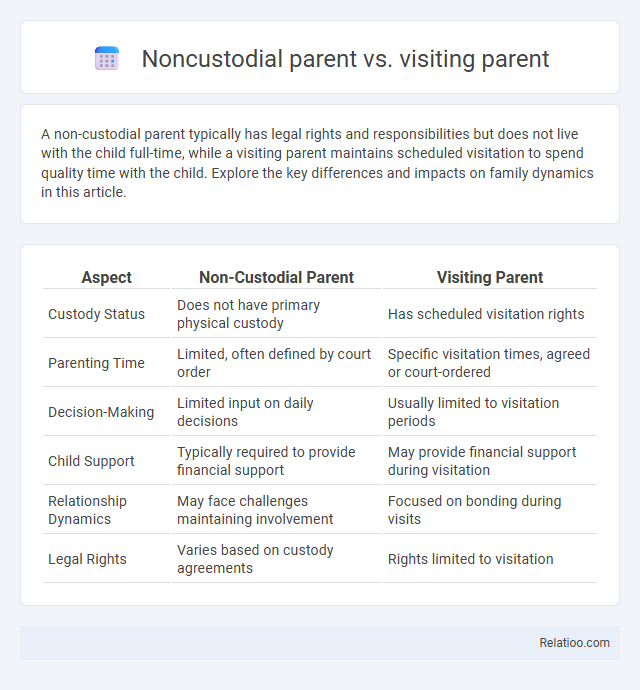A non-custodial parent typically has legal rights and responsibilities but does not live with the child full-time, while a visiting parent maintains scheduled visitation to spend quality time with the child. Explore the key differences and impacts on family dynamics in this article.
Table of Comparison
| Aspect | Non-Custodial Parent | Visiting Parent |
|---|---|---|
| Custody Status | Does not have primary physical custody | Has scheduled visitation rights |
| Parenting Time | Limited, often defined by court order | Specific visitation times, agreed or court-ordered |
| Decision-Making | Limited input on daily decisions | Usually limited to visitation periods |
| Child Support | Typically required to provide financial support | May provide financial support during visitation |
| Relationship Dynamics | May face challenges maintaining involvement | Focused on bonding during visits |
| Legal Rights | Varies based on custody agreements | Rights limited to visitation |
Understanding Non-Custodial and Visiting Parent Roles
Non-custodial parents have legal rights and responsibilities but do not live with the child full-time, while visiting parents typically refer to non-custodial parents who have scheduled visitation to spend time with their child. Understanding your role involves recognizing the importance of maintaining consistent communication and supporting your child's emotional well-being despite physical separation. Courts often emphasize the child's best interests, ensuring visitation agreements promote healthy relationships between children and both parents.
Legal Definitions: Non-Custodial Parent vs Visiting Parent
A non-custodial parent is legally defined as the parent who does not have primary physical custody of the child but retains certain legal rights and responsibilities, including visitation and decision-making input. A visiting parent is specifically recognized as the non-custodial parent granted court-ordered visitation or parenting time to maintain a relationship with the child. Understanding these distinctions ensures your rights and obligations are clearly outlined within family law frameworks.
Parental Rights in Different Custody Arrangements
Parental rights in custody arrangements vary significantly between non-custodial and visiting parents, where non-custodial parents retain legal rights such as decision-making and access to the child despite not having primary physical custody. Visiting parents typically have scheduled visitation rights without full legal custody, limiting their authority in major decisions related to education, healthcare, or relocation. Understanding these distinctions is crucial for defining responsibilities, ensuring compliance with court orders, and protecting the best interests of the child in diverse custody scenarios.
Visitation Schedules and Their Impact
Visitation schedules dictate the time a non-custodial or visiting parent spends with their child, significantly influencing parent-child relationships and child well-being. Structured visitation fosters consistent bonding opportunities, while irregular or limited schedules may hinder emotional connection and stability. Courts often customize visitation agreements to balance parental involvement, prioritize children's best interests, and adapt to unique family dynamics.
Responsibilities of Non-Custodial Parents
Non-custodial parents are primarily responsible for supporting their child's financial needs through child support payments and maintaining consistent communication to foster emotional bonds despite not living with the child. Visiting parents, often the same as non-custodial parents, have the responsibility to adhere to legally established visitation schedules, ensuring quality time spent nurturing the parent-child relationship. Non-custodial parents must also cooperate with custodial parents in decision-making processes regarding education, health care, and general welfare to promote the child's best interests.
Emotional Effects on Children
Children with non-custodial parents often experience feelings of abandonment and insecurity due to limited daily interaction. Visiting parents may face challenges in maintaining emotional bonds, which can lead to frustration and inconsistencies in the child's sense of stability. Emotional effects vary widely depending on the quality of communication, consistency in visitation schedules, and parental cooperation.
Communication and Co-Parenting Strategies
Effective communication between non-custodial and visiting parents is crucial for successful co-parenting, requiring consistent updates about the child's well-being and scheduling. Utilizing respectful dialogue and clear boundaries fosters collaboration, reducing conflicts and promoting the child's stability. Establishing shared parenting plans with defined responsibilities helps both parties stay aligned, enhancing trust and cooperation.
Modifying Custody and Visitation Agreements
Modifying custody and visitation agreements requires understanding the distinct roles of non-custodial, visiting, and custodial parents, each with specific legal rights and responsibilities. You must file a petition with the court to request changes, demonstrating a substantial change in circumstances affecting the child's welfare. Courts prioritize the child's best interest, evaluating factors like parental involvement, stability, and ability to provide a safe environment during modification decisions.
Financial Obligations and Child Support
Non-custodial parents are legally required to provide financial support for their child's upbringing, typically through mandated child support payments. Visiting parents may not have primary financial responsibilities but are often expected to contribute proportionally to expenses when the child is in their care. Custodial parents usually manage the child's daily expenses and may seek child support from non-custodial parents to ensure the child's needs are met.
Navigating Common Challenges and Solutions
Navigating common challenges between non-custodial, visiting, and custodial parents requires clear communication and establishing consistent visitation schedules to minimize conflicts. You can address misunderstandings by utilizing co-parenting apps and mediation services designed to foster cooperation and prioritize the child's well-being. Implementing structured parenting plans and seeking legal advice when necessary ensures that all parties understand their rights and responsibilities, promoting a healthier co-parenting relationship.

Infographic: Non-custodial parent vs Visiting parent
 relatioo.com
relatioo.com